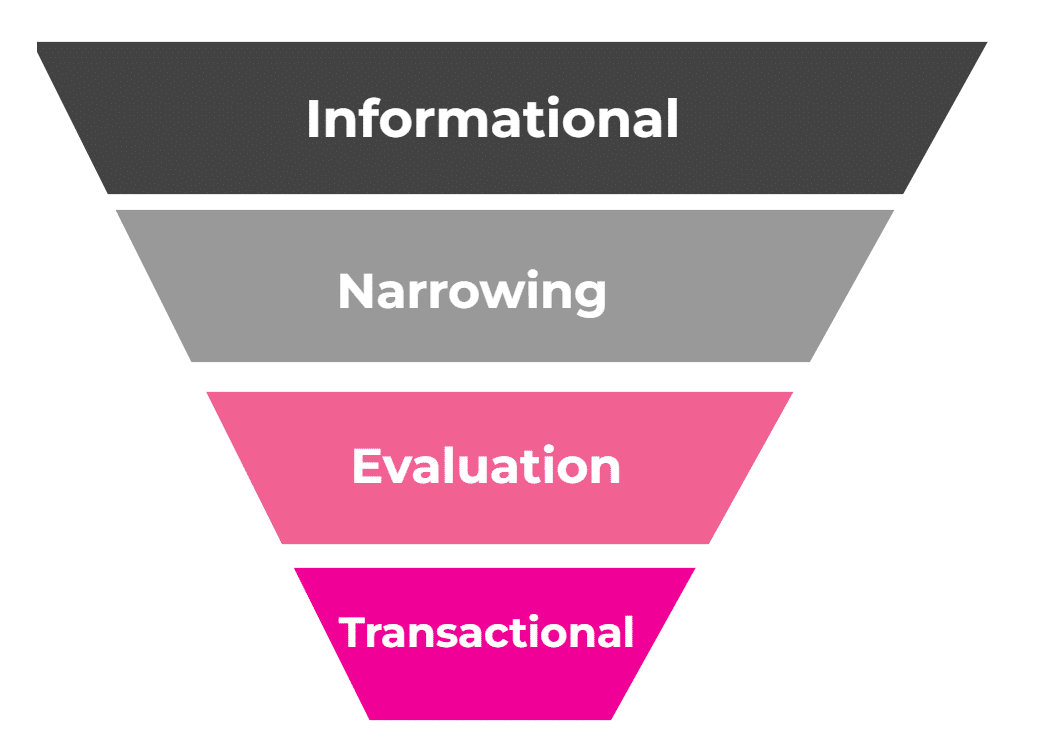Blog writing is a cornerstone of website growth. It allows brands to establish themselves as thought leaders and appear more frequently in relevant search queries. But here’s the secret sauce: incorporating SEO factors into your writing doesn’t just showcase your expertise, it also propels your content to the top of search results.
This guide will equip you with the knowledge to craft high-quality blog posts that resonate with both readers and search engines.
Defining Your Content Goals
The key to effective content creation? Setting clear goals. Before you dive into writing, ask yourself: What’s the primary purpose of this blog post? Are you aiming to inform readers, solve their problems, promote services in a specific location, or drive sales (transactions)?
User intent in SEO is defined as what a user’s objective is when they type a query in the search engine and it’s funnelled into 4 – Informational, Commercial, Navigational, and Transactional.
Here’s a breakdown of user intent in SEO, categorised into four main stages:
- Informational
- Commercial
- Navigational
- Transactional
Readers are seeking knowledge. Their searches might involve broad keywords or “seed keywords”. These keywords contain high-volume searches.
Users are in the evaluation stage, looking for products or services. This is your chance to showcase how your business can add value. These keywords usually contain “near me”, “company”, and “services”.
Users are familiar with your brand and are searching for specific pages on your website using branded keywords.
Users are ready to make a purchase. They know exactly what they want and where they want to buy it.
Understanding user intent helps you tailor your content to their specific needs.
The Technical Side of SEO Writing
- Keyword Placement
- Keyword stuffing
- The Power of Links
- Focus on a Single Topic (with Subtopics)
Incorporate relevant keywords throughout your blog post to establish topical relevance for search engine queries. Don’t forget, search engines prioritise content that matches what users are searching for.
When keyword density is no longer beneficial to focus on, keyword placement has replaced that importance, which heading you place a keyword brings importance.
For example, an H1 will be the main topic while the remaining subheadings provide context to the main topic to further understand the main topic. Therefore, H1 will remain the important keyword.
Overstuffing keywords for the sake of SEO is a bad practice and can actually hurt your ranking.
Prioritise natural language flow, and don’t contort your writing just to fit keywords in a specific order.
For example, if your research suggests “cheap glasses Gold Coast” is a popular search, use a natural phrasing like “Cheap Glasses in Gold Coast.”
Internal links act like signposts, directing readers to other relevant content on your website that provides additional explanation or information. You can also link to external sources to demonstrate expertise and showcase reliance on trustworthy data. Linking helps search engines crawl your website and understand its structure and content.
Sticking to one main topic with well-defined subtopics maximises the relevancy and makes it easy to digest. Imagine trying to cram everything about building a barbecue on one page – it would be overwhelming! Subtopics add depth and context, making your blog post a comprehensive and informative resource.
SEO Blunders to Avoid
- Keyword Cannibalization
- Thin Content
- Content Cloning
Don’t turn your blog into a keyword graveyard. Stuffing your content with keywords is a transparent tactic that both readers and search engines will see through.
Not providing much substantial value with little subtopics or context will not gain traction in the search. Users (and search engines) value informative content with substance.
The internet is vast, but resist the temptation to copy and rephrase someone else’s work. It’s a waste of time and could land you in hot water for plagiarism.
The Bottom Line: Value is King
The most important takeaway? Focus on providing value to your readers. Write clear, well-structured content and avoid sounding spammy. By following these tips, you’ll be crafting blog posts that not only rank highly in search results but also resonate with your target audience. Now get out there and start creating content that shines!
Rebel Agency offers Overall SEO Services which covers everything you need to grow your website from content to backlinks.





